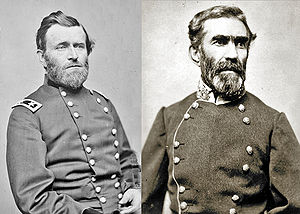
Back حملة تشاتانوغا Arabic Batalla de Chattanooga Catalan Slaget ved Chattanooga Danish Schlacht von Chattanooga German Batalla de Chattanooga Spanish کمپین چاتانوگا FA Campagne de Chattanooga French Չաթանուգայի ճակատամարտ HY Campagna di Chattanooga Italian 第三次チャタヌーガの戦い Japanese
| Chattanooga campaign | |||||||
|---|---|---|---|---|---|---|---|
| Part of the American Civil War | |||||||
 Maj. Gen. Ulysses S. Grant and Gen. Braxton Bragg, commanding generals of the Chattanooga campaign | |||||||
| |||||||
| Belligerents | |||||||
|
|
| ||||||
| Commanders and leaders | |||||||
|
Ulysses S. Grant William S. Rosecrans George Henry Thomas William Tecumseh Sherman Joseph Hooker |
Braxton Bragg James Longstreet John C. Breckinridge William J. Hardee | ||||||
| Units involved | |||||||
|
Army of the Cumberland Military Division of the Mississippi | Army of Tennessee | ||||||
| Strength | |||||||
| 72,533 "present for duty equipped"[2] | 48,948 "present for duty"[3] | ||||||
| Casualties and losses | |||||||
| 5,824 total |
6,000–8,000 (estimated)[5] (8,684 men killed, wounded or prisoners)[6] | ||||||
The Chattanooga campaign[7] was a series of maneuvers and battles in October and November 1863, during the American Civil War. Following the defeat of Maj. Gen. William S. Rosecrans's Union Army of the Cumberland at the Battle of Chickamauga in September, the Confederate Army of Tennessee under Gen. Braxton Bragg besieged Rosecrans and his men by occupying key high terrain around Chattanooga, Tennessee. Maj. Gen. Ulysses S. Grant was given command of Union forces in the West which was now consolidated under the Division of the Mississippi. Significant reinforcements also began to arrive with him in Chattanooga from Mississippi and the Eastern Theater. On October 18, Grant removed Rosecrans from command of the Army of the Cumberland and replaced him with Major General George Henry Thomas.
During the opening of a supply line (the "Cracker Line") to feed the starving men and animals in Chattanooga, a force under Maj. Gen. Joseph Hooker fought off a Confederate counterattack at the Battle of Wauhatchie on October 28–29, 1863. On November 23, the Army of the Cumberland advanced from the fortifications around Chattanooga to seize the strategic high ground at Orchard Knob while elements of the Union Army of the Tennessee under Maj. Gen. William Tecumseh Sherman maneuvered to launch a surprise attack against Bragg's right flank on Missionary Ridge. On November 24, Sherman's men crossed the Tennessee River in the morning and then advanced to occupy high ground at the northern end of Missionary Ridge in the afternoon. The same day, a mixed force of almost three divisions under Maj. Gen. Joseph Hooker defeated the Confederates in the Battle of Lookout Mountain. The next day they began a movement toward Bragg's left flank at Rossville.
On November 25, Sherman's attack on Bragg's right flank made little progress. Hoping to distract Bragg's attention, Grant ordered Thomas's army to advance in the center and take the Confederate positions at the base of Missionary Ridge. The untenability of these newly captured entrenchments caused Thomas's men to surge to the top of Missionary Ridge and, with the help of Hooker's force advancing north from Rossville, routed the Confederate Army of Tennessee. The Confederates retreated to Dalton, Georgia, successfully fighting off the Union pursuit at the Battle of Ringgold Gap. Bragg's defeat eliminated the last significant Confederate control of Tennessee and opened the door to an invasion of the Deep South, leading to Sherman's Atlanta campaign of 1864.
- ^ ""The Battle of Chattanooga"". CivilWarHome.com. Archived from the original on March 4, 2016. Retrieved June 25, 2016.
- ^ Abstract from returns of the Union forces at and about Chattanooga November 20, 1863 (Official Records, Series I, Vol. XXXI, Part 2, pp. 12–13)
- ^ Abstract from returns of the Army of Tennessee for October 31 and December 10, 1863 (Official Records, Series I, Vol. XXXI, Part 2, page 656)
- ^ Return of casualties in the Union forces (see also note at bottom of p. 80): Official Records, Series I, Vol. XXXI, Part 2, pp. 80–90
- ^ See Confederate casualties: Battle of Lookout Mountain and Battle of Missionary Ridge.
- ^ Chisholm, Hugh, ed. (1911). . Encyclopædia Britannica. Vol. 6 (11th ed.). Cambridge University Press. pp. 7–9.
- ^ The National Park Service's Civil War Sites Advisory Commission Archived November 6, 2013, at the Wayback Machine classifies two campaigns for this period: Reopening the Tennessee River (Battle of Wauhatchie) and Chattanooga-Ringgold (the Third Battle of Chattanooga, frequently known as the Battles for Chattanooga, and the Battle of Ringgold Gap).